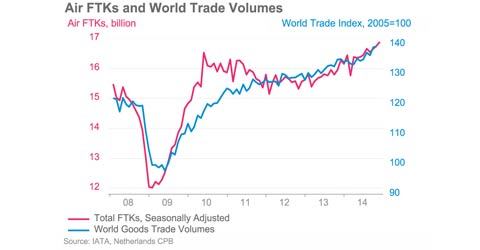
Asia and Middle East continue to lead air freight growth
Concerns have been rising about the health of the global economy at the start of 2015, and business confidence has weakened. But there was little sign of major cause for concern in the November 2014 air freight data released by the International Air Transport Association (IATA). Its continued growth reflected the broader acceleration of world […]

Concerns have been rising about the health of the global economy at the start of 2015, and business confidence has weakened. But there was little sign of major cause for concern in the November 2014 air freight data released by the International Air Transport Association (IATA). Its continued growth reflected the broader acceleration of world trade that began in mid-2014. Weakness in air freight is usually one of the first signs of economic weakness. Growth did slow in November, but not by much.
The IATA report for November 2014 data for global air freight markets showed demand measured in freight tonne kilometers (FTK) grew 4.2 percent compared to November 2013. Capacity grew by 3.3 percent over the previous November. Compared to October 2014, air freight demand expanded by a healthy 0.8 percent.
The most significant growth was recorded by carriers in the Asia-Pacific and Middle East regions, at 5.9 percent and 12.9 percent, respectively. Carriers in these regions captured the vast majority of the global increase (93 percent). Carriers in Asia-Pacific accounted for 55 percent of the total year-on-year growth (with a market share of 39.7 percent), while airlines in the Middle East region contributed a further 38 percent of growth (with a market share of 13.3 percent).
An important development emerged at the end of 2014 which, if it continues, bodes well for air freight markets. Air freight is closely linked to world trade (by value about a third of goods traded internationally are shipped by air). Air cargo growth stagnated from 2011 as world trade volumes basically grew in tandem with domestic production. A strong growth trend in cross-border trade emerged over the second half of 2014 (while domestic industrial production remained stable) which has had a positive impact on air cargo volumes.
“More goods are being traded internationally and that is fueling the growth in air freight. It was clear in November that most of that growth is being captured by carriers in the dynamic and relatively business-friendly Asia-Pacific and Middle East regions. This year we expect air freight markets to expand by 4.5 percent, outpacing projected growth in world trade (4.0 percent). But that optimism is tempered by the many macro-economic and political risks that continue to impact trade flows,” said Tony Tyler, IATA’s Director General and CEO.
Uneven airline performance reflects uneven growth in trade flows. The two regions of recent strength in trade have been the US and Emerging Asia. Other regions remain relatively weak. There have also been special factors which have influenced the data, such as congestion at US West coast ports that led to some temporary switch to air and the sanctions on Russia which have affected trade flows in goods like perishables.

